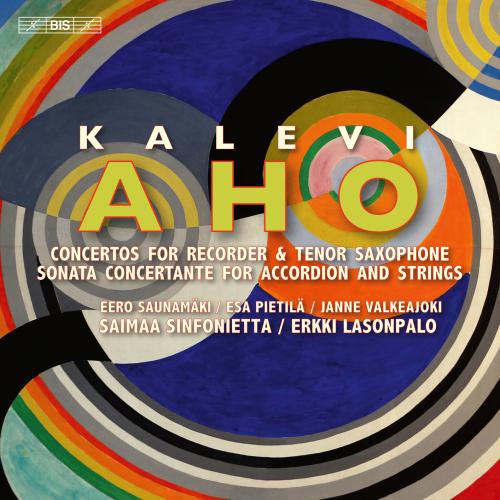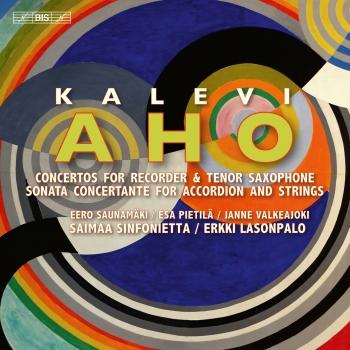
Aho: Concertante Works for Recorder, Saxophone and Accordion Saimaa Sinfonietta & Erkki Lasonpalo featuring Eero Saunamäki, Esa Pietilä and Janne Valkeajoki
Album Info
Album Veröffentlichung:
2023
HRA-Veröffentlichung:
18.08.2023
Label: BIS
Genre: Classical
Subgenre: Concertos
Interpret: Saimaa Sinfonietta & Erkki Lasonpalo featuring Eero Saunamäki, Esa Pietilä and Janne Valkeajoki
Komponist: Kalevi Aho (1949)
Das Album enthält Albumcover Booklet (PDF)
- Kalevi Aho (b. 1949): Concerto for Recorder and Chamber Orchestra:
- 1 Aho: Concerto for Recorder and Chamber Orchestra: Misterioso - Presto 04:28
- 2 Aho: Concerto for Recorder and Chamber Orchestra: Crotchet = 100 02:47
- 3 Aho: Concerto for Recorder and Chamber Orchestra: Presto 02:49
- 4 Aho: Concerto for Recorder and Chamber Orchestra: Allegretto 04:09
- 5 Aho: Concerto for Recorder and Chamber Orchestra: Vivace 02:47
- 6 Aho: Concerto for Recorder and Chamber Orchestra: Coda 03:28
- Concerto for Tenor Saxophone and Small Orchestra:
- 7 Aho: Concerto for Tenor Saxophone and Small Orchestra: Mesto 03:29
- 8 Aho: Concerto for Tenor Saxophone and Small Orchestra: Interludio I 00:50
- 9 Aho: Concerto for Tenor Saxophone and Small Orchestra: Vivacissimo, leggiero 04:05
- 10 Aho: Concerto for Tenor Saxophone and Small Orchestra: Interludio II 01:46
- 11 Aho: Concerto for Tenor Saxophone and Small Orchestra: Andante, dolente 03:40
- 12 Aho: Concerto for Tenor Saxophone and Small Orchestra: Allegretto ritmico 04:28
- 13 Aho: Concerto for Tenor Saxophone and Small Orchestra: Cadenza 02:03
- 14 Aho: Concerto for Tenor Saxophone and Small Orchestra: Epilogo (Andante) 03:50
- Sonata concertante for Accordion and Strings:
- 15 Aho: Sonata concertante for Accordion and Strings: I. Prelude (Molto rubato) 05:14
- 16 Aho: Sonata concertante for Accordion and Strings: Passacaglia 07:34
- 17 Aho: Sonata concertante for Accordion and Strings: II. Prelude (Leggiero) 04:35
- 18 Aho: Sonata concertante for Accordion and Strings: Fugue (Andante - Più mosso - Leggiero) 09:06
Info zu Aho: Concertante Works for Recorder, Saxophone and Accordion
Concertante works featuring the recorder, tenor saxophone and accordion are few and far between. Stimulated by daring soloists, the prolific Finnish composer Kalevi Aho has composed such works, contributing in his own way to the development of an original and attractive repertoire. The Concerto for Recorder requires the soloist to play four types of recorder, from bass to sopranino. The work explores extended techniques and also does not shy away from flashbacks to the golden age of the instrument.
Aho received the initial impetus for his Concerto for tenor saxophone after a concert by Esa Pietilä. Aho wrote a concerto with contrasting sections that gradually exploits the full potential of the tenor saxophone and also makes use of an oriental goblet drum (darabuka) that sometimes also takes centre stage.
The origins of the Sonate Concertante for accordion and strings goes back to Aho’s first Sonata for accordion of 1984. Noting its orchestral character, soloist Janne Valkeajoki suggested making a concertante version with strings. Here, Aho sought to extend the technical possibilities of the instrument to the maximum and to write for it a work of astounding virtuosity, like Franz Liszt’s most demanding piano compositions.
Esa Pietilä, tenor saxophone
Eero Saunamäki, saxophone
Janne Valkeajoki, accordion
Saimaa Sinfonietta
Erkki Lasonpalo, conductor
Esa Pietilä
started his jazz career similarly as many of his collegues, by playing saxophone in a big band. From Pori Big Band he moved to play in Turku Big Band and Settlement Big Band and finally ending up playing in Espoo Big Band. The first international jazz performances of Pietilä were with Espoo Big Band as the orchestra did co-operation with i.a. Thad Jones, Art Farmer and Carla Bley. The first rcording for the saxophonist was EBB's and Sakari Kukko's Moonlight Caravan & Finnish Characters in 1990.
Pietilä started his studies at the jazz department of Sibelius Academy in 1987 and founded his own quartet a couple of years later, that performed around Finland actively. In 1996 after graduating from Sibelius Academy, saxophonist expanded his quartet into a sextet and named it The Case that released the album Codes in 1997 (Trick Music) that included many unique compositions by Pietilä. The expression of The Case was electronic and some songs had even programmed sequencebacksgrounds. The next album of the saxophonist, with a quartet set up specially for the album, was an acoustic record Fastjoik (A-Records 1998) that had Pietilä's diverse compositions, interpreted smoothy by the band, as it's core. Pietilä's compositions on this album got lots of good feedback from the critics of Finnish and international jazzmagazines.
In 2001 Pietilä formed a trio with bassist Ulf Krokfors and drummer Markku Ounaskari. The expression was a lot more freer than before and the material in the compositions was trimmed to include only the essential, the themes. Pietilä's skills were noticed in this challenging line-up and he proved to be a great free jazz saxophonist. Trio performed for the first time in 2001 and released it's debutalbum Direct (Fiasko Records 2003) a couple of years later.
The trio has been the main group for the saxophonist through the whole 21st century. The band did a tour organized by the Finnish Jazz Federation in spring 2004 and has performed abroad regularly. Once in a while the trio has been extended with featuring soloists, like guitarist Raoul Björkenheim. Pietilä's trio worked with the original line-up 'til 2009 and ever since Ounaskari and Krokfors have been replaced by younger musicians, bass player Ville Herrala and drummer Mika Kallio. Other groups for Pietilä, besides many duos with international artists, have been the Brain Inventory Trio formed with American pianist Michael Jefry Stevens and Finnish cellist Juho Laitinen, and 4 STREAMS with pianist Iro Haarla, Markku Ounaskari and Ulf Krokfors.
Other internationally known musicians that have done co-operation with Pietilä are i.a. Michael Jefry Stevens, Mathias Eick, Jeff Siegel, Harvey Sorgen, Karl Berger, Mark Helias, Brian Melvin, Heiri Kaenzig, Raoul Björkenheim, Christoph Baumann, Baenz Öster, Franziska Baumann, Mike Nock, Ron McClure, Claudio Fasoli, Jaak Sooäär, Anders Begcrantz, Odean Pope, Raoul Björkenheim, Iro Haarla, Filip Augustson, John Esposito, Hilmar Jensson, Kjartan Valdemarsson, Fabian Kuratli and Arthur Kell.
Erkki Lasonpalo
began his conducting studies in Jorma Panula’s class for young conductors and in 2007 graduated with top grades from the Sibelius Academy’s conducting faculty, where his teacher was Leif Segerstam. Since obtaining his diploma, Lasonpalo has consolidated his position by appearing as a guest conductor with Finnish orchestras and with an increasing number of international engagements. He is artistic director of the Kemi City Orchestra and Helsinki Sinfonietta, and artistic partner of the St Michel Strings. Lasonpalo is also director of the Heinävesi Music Festival, which under his leadership has become one of Finland’s most important summer art music festivals.
Booklet für Aho: Concertante Works for Recorder, Saxophone and Accordion









